

Nema.lis.illinois.edu. 2010:MIREX HOME - MIREX Wiki. From MIREX Wiki MIREX 2010 Deadline Dates We have very tight scheduling constraints this year because of the early convening of ISMIR 2010 in Utrecht.
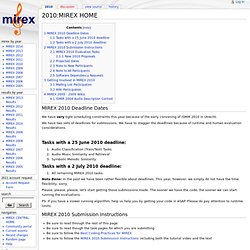
We have two sets of deadlines for submissions. We have to stagger the deadlines because of runtime and human evaluation considerations. Tasks with a 25 June 2010 deadline: Audio Classification (Train/Test) Tasks Audio Music Similarity and Retrieval Symbolic Melodic Similarity Tasks with a 2 July 2010 deadline: All remaining MIREX 2010 tasks. Nota Bene: In the past we have been rather flexible about deadlines. Please, please, please, let's start getting those submissions made. PS: If you have a slower running algorithm, help us help you by getting your code in ASAP. MIREX 2010 Submission Instructions MIREX 2010 Evaluation Tasks Results as of Monday 24th May 2010: Total individual responses = 74 download these results as csv Hence, the IMIRSEL team has decided to attempt the running of the following tasks at MIREX 2010:
2010 – 11th International Society for Music Information Retrieval Conference » f(mir) 2010. Informationen über Quellcode-Paket madplay in maverick. VB.NET LameMP3 Shell. Download source files - 7.89 Kb Introduction The idea for LameShell came from my wish to be able to resample MP3 files in VB.NET.
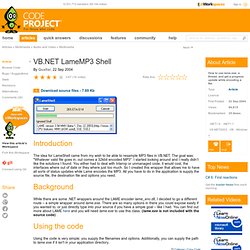
The goal was: "Whatever valid file goes in, out comes a 32kbit encoded MP3". I started looking around and I really didn’t like the solutions I found. You either had to deal with Interop or unmanaged code, it would cost, the interfaces where out of date or they where just too much. Background While there are some .NET wrappers around the LAME encoder lame_enc.dll, I decided to go a different route – a simple wrapper around lame.exe.
Using the code Using the code is very simple; you supply the filenames and options. Dim WithEvents _lameShell As New LameShell [...] LAME MP3 Encoder. Laurent de Soras - Productions. Soundtrackers were the first tools of the computer-only music era.
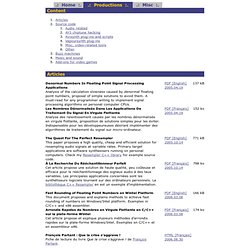
They were characterised by their austerity, making them look like hexadecimal hacking programs, and their total lack of liveness. Conversely, they allowed ultra-fast composing and great ease of use once mastered. Well, below are quite old songs, and they are not very glorious... They are listed in alphabetical order. Numbering of the Dreamxx songs is roughly chronological. Unless specified explicitely, the files in this section are under the Creative Commons Attribution-NonCommercial-ShareAlike 2.5 License. MOD = Classic ProTracker module, GT2 = Graoumf Tracker 2 module, BMX = Buzz module, OGG = Ogg Vorbis sound files. Jj's useful and ugly FFT page.
Untitled. Ein Beispiel zu dieser Zerlegung findet sich in der Online-Version des Buches "Comprehensive Mathematics for Computer Scientists" (=> Example 182).

Siplca-segmentation. Music structure segmentation based on SIPLCA analysis of chroma features This package contains the implementation of the algorithm for identifying repeated harmonic patterns in music and structure segmentation described in [1].
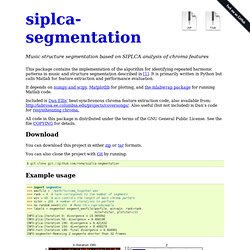
It is primarily written in Python but calls Matlab for feature extraction and performance evaluation. It depends on numpy and scipy, Matplotlib for plotting, and the mlabwrap package for running Matlab code. Asataka Goto: Musicream. This project is proposed and researched by Takayuki Goto and Masataka Goto.

Japanese version is here. Introduction: Musicream is a new music playback interface that lets a user unexpectedly come across various musical pieces similar to those liked by the user. With most previous ``query-by-example'' interfaces used for similarity-based searching, for the same query and music collection a user will always receive the same list of musical pieces ranked by their similarity and opportunities to encounter unfamiliar musical pieces in the collection are limited. Video Clips Demonstration video of Musicream Full version (high quality): Demonstration of Musicream (46,621,764 bytes, 3 min 46 sec, MPEG-1 file) Short excerpt version (low quality): 1. Praat: doing Phonetics by Computer.
PLP and RASTA (and MFCC, and inversion) in Matlab using melfcc.m and invmelfcc.m. Dan Ellis : Resources : Matlab : Introduction One of the first decisions in any pattern recognition system is the choice of what features to use: How exactly to represent the basic signal that is to be classified, in order to make the classification algorithm's job easiest.

Speech recognition is a typical example. Through more than 30 years of recognizer research, many different feature representations of the speech signal have been suggested and tried. The most popular feature representation currently used is the Mel-frequency Cepstral Coefficients or MFCC. Another popular speech feature representation is known as RASTA-PLP, an acronym for Relative Spectral Transform - Perceptual Linear Prediction. RASTA-PLP is implemented in a number of programs, such as the 'rasta' program, and its enhanced version 'feacalc', which are distributed for Unix as part of the SPRACHcore package. Computer Audition Laboratory - UCSD. Million Song Dataset. Our main goal is to provide you with data because you know what you want to do with it.
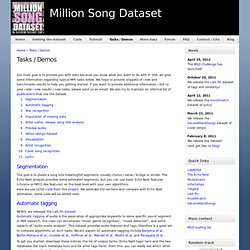
Still, we give some information regarding typical MIR tasks below. We hope to provide snippets of code and benchmarks results to help you getting started. If you want to provide additional information / link to your code / new results / new tasks, please send us an email! We also try to maintain an informal list of publications that use the dataset. Segmentation The goal is to divide a song into meaningfull segments, usually chorus / verse / bridge or similar. Automatic tagging NEWS: we released the Last.fm dataset. To get you started, download these indices, the list of unique terms (Echo Nest tags) here and the two databases (for track metadata here and for artist tags here).